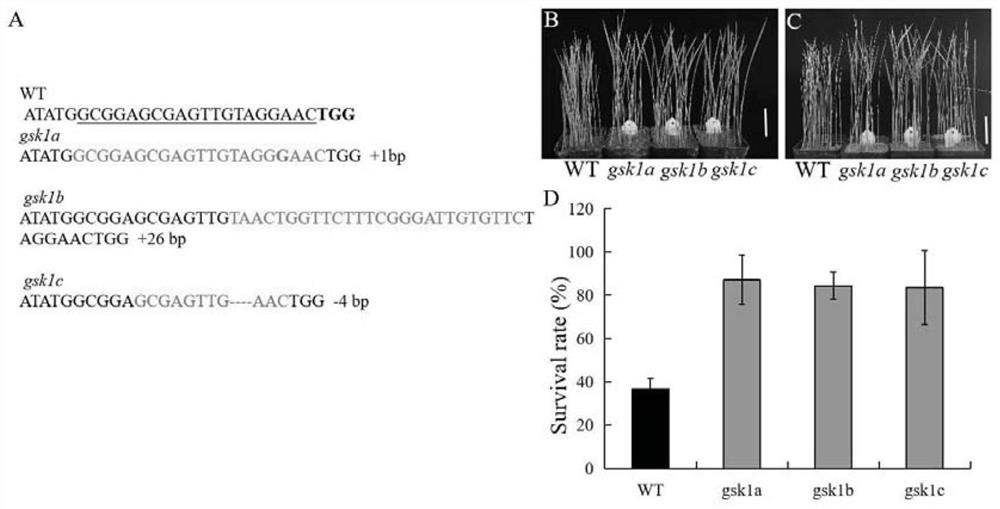Method for regulating and controlling salt tolerance of rice
A technology of salt tolerance and rice, applied in the field of molecular biology and genetic engineering, can solve the problems of sensitivity to BR treatment, unclear action of rice GSK3 kinase, and enlarged osgsk3 leaf angle
- Summary
- Abstract
- Description
- Claims
- Application Information
AI Technical Summary
Problems solved by technology
Method used
Image
Examples
Embodiment 1
[0032] Example 1: Phenotype identification of rice salt-tolerance-related mutant gsk1
[0033] The salt-tolerance-related mutant gsk1 was screened from the rice variety Dongjin T-DNA insertion mutant library. The wild-type and mutant plants grown in an indoor light growth box for 2 weeks were placed in 140mM NaCl solution for 5 days, then cultured in water for 7 days, and the survival rate of the plants was counted. Compared with the wild type, the mutant gsk1 salt tolerance Significantly increased( figure 1 A-B).
[0034] 1. For cloning the mutant gene of the mutant gsk1, design three detection primers P1 (as shown in SEQ ID No.3), P2 (as shown in SEQ ID No.4) and P3 according to the flanking sequence of the T-DNA insertion mutant (as shown in SEQ ID No.5)( figure 2 A). PCR amplification reaction system (10 μL): 2 μL DNA, 1.6 μL dNTP Mixture, 3 μL Buffer, 2 μL Primer, 0.1 μL DNA Polymerase, 1.3 μL ddH 2 O, reaction program: 95°C for 2min; 98°C for 10s, 58°C for 30s, 72°...
Embodiment 2
[0045] Example 2: Expression analysis and subcellular localization of OsGSK1
[0046] Take wild-type roots, stems, leaves, spikes, seeds, and leaf tissues of two-week-old wild-type plants treated with 140mM NaCl, 4°C, 1μMABA and grind them with liquid nitrogen. (CW0559S) to extract total RNA. The reverse transcription kit (PrimeScript Reverse Transcriptase kit) from Dalian Bao Biological Co., Ltd. was used to reverse the cDNA of the total RNA. Using cDNA as a template, SYBR premix Ex TaqTM (TaKaRa, Japan) kit was selected for Real-time PCR, amplified on Bio-Rad fluorescent quantitative PCR instrument CFX96, using 2 -ΔΔCT method for expression analysis. The results showed that OsGSK1 was expressed in a constitutive mode, with the highest expression level in panicles ( Figure 4 A). At the same time, the expression of OsGSK1 was induced by salt, low temperature and ABA ( Figure 4 B).
[0047] The full-length CDS of OsGSK1 (removing the terminator) was cloned into the vect...
Embodiment 3
[0048] Example 3: Screening and identification of OsGSK1 interacting proteins
[0049] The full-length CDS of OsGSK1 was connected to the pGBKT7(BD) vector (purchased from Clontech), and the leaf tissue library treated with salt stress was screened. For the yeast transformation step, refer to the instructions of Clontech. Five VP1- and six OsbZIP72-related positive clones were identified, respectively. The full-length CDS of clone VP1 and OsbZIP72 (as shown in SEQ ID No.10, 11) was connected to pGADT7(AD) vector for yeast co-transformation verification. The results showed that OsGSK1 interacted with VP1 and OsbZIP72 in yeast ( Figure 6 A).
[0050] OsGSK1, VP1 and OsbZIP72 (terminator removed) were fused to the N-terminus (nYFP) and C-terminus (cYFP) of yellow fluorescent protein YFP using the ClonExpress II One Step Cloning Kit (Cat#C112) from Novizan Biotechnology Company, respectively. The positive recombinants were transformed into Agrobacterium, and then infected the ...
PUM
 Login to View More
Login to View More Abstract
Description
Claims
Application Information
 Login to View More
Login to View More - R&D
- Intellectual Property
- Life Sciences
- Materials
- Tech Scout
- Unparalleled Data Quality
- Higher Quality Content
- 60% Fewer Hallucinations
Browse by: Latest US Patents, China's latest patents, Technical Efficacy Thesaurus, Application Domain, Technology Topic, Popular Technical Reports.
© 2025 PatSnap. All rights reserved.Legal|Privacy policy|Modern Slavery Act Transparency Statement|Sitemap|About US| Contact US: help@patsnap.com



